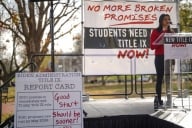You have /5 articles left.
Sign up for a free account or log in.

iStock
Amid all the literature about the merits of college diversity, an important trend is often overlooked, according to a new study in The Journal of Higher Education. Although more students report having positive experiences by studying and living with those from different racial, religious, political, gender and ethnic groups, negative experiences are fairly common, too -- and they can impair student learning and cognitive development, according to the study.
The study, titled “Engaging With Diversity: How Positive and Negative Diversity Interactions Influence Students’ Cognitive Outcomes,” seeks to add to the conversation about campus diversity by examining the incidence and influence of negative diversity experiences.
The authors found that, in a sample of over 2,500 students at four-year institutions, 43 percent of African-American students reported having a “high” number of negative diversity interactions, as well as 37 percent of Hispanic students and 40 percent of Asian students. Twenty-five percent of white students said the same. These negative experiences -- which may reflect hostile, hurtful or tense interactions with students who are categorically different from them -- have negative consequences for the development of critical thinking skills and show a need for cognitive development among some white students and students of color, the study found.
On the other hand, all four ethnic and racial groups studied had more positive diversity experiences than negative -- 47 percent of African-Americans, 56 percent of Hispanics, 53 percent of Asians and 30 percent of white students. They also noted that positive diversity experiences -- which might be associated with constructive discussions, shared meaningful experiences or friendships across different races, religions, genders or ethnicities -- encourages students to challenge their viewpoints and consider complex issues.
Most research in this area has identified positive or neutral diversity experiences, but because of that, it clearly ignores an important dimension of the diversity experience, said Josipa Roksa, lead author of the study and a professor of sociology and education at the University of Virginia. Her study tries to fill that void.
In exploring how often students have a bad experience with someone of a different background and what the repercussions of those bad experiences are, the authors are not critiquing diversity itself, Roksa said. They are instead critiquing the way colleges prepare their students to embrace diversity.
Negative experiences, as recorded in the study, occurred when students felt their ideas and opinions were shut down due to prejudice and discrimination; when they felt insulted or threatened based on their racial, religious, ethnic or gender identity; or when they had hurtful, unresolved interactions with diverse students.
“Higher education institutions really have not delivered on their promise of diversity,” Roksa said. “It’s one thing to have a diverse student body -- that is a crucial first step -- but you have to ensure that interaction between groups is positive.”
“To me, this is about intentionality,” she added. “Higher education institutions are not helping students develop the skills to navigate that diversity, to engage it, to embrace it, to make it a positive experience.”
Colleges have a responsibility, Roksa said, to address both the positive and negative outcomes of bringing together students from very different backgrounds, especially since many students are not exposed to diversity in their K-12 educations.
Most negative diversity experiences in college are minor incidents that don’t get a lot of attention or scrutiny, Roksa said, but based on the results of the study, they clearly leave an impression. She emphasized the importance of colleges initiating that conversation early, before minor incidents escalate and become a national issue.
“To me, this article is a call for colleges and universities to engage diversity on a deeper level -- not just by admitting diverse student bodies but by helping students embrace and benefit from diversity,” Roksa said. “And that requires concerted effort.”
The other authors of the study are Cindy Ann Kilgo, a professor of educational leadership at the University of Alabama; Teniell L. Trolian, a professor of education policy and leadership at the University of Albany, State University of New York; Ernest T. Pascarella, a professor of higher education at the University of Iowa; Charles Blaich, director of the Center for Inquiry at Wabash College; and Kathleen S. Wise, associate director of the Center for Inquiry at Wabash College.








